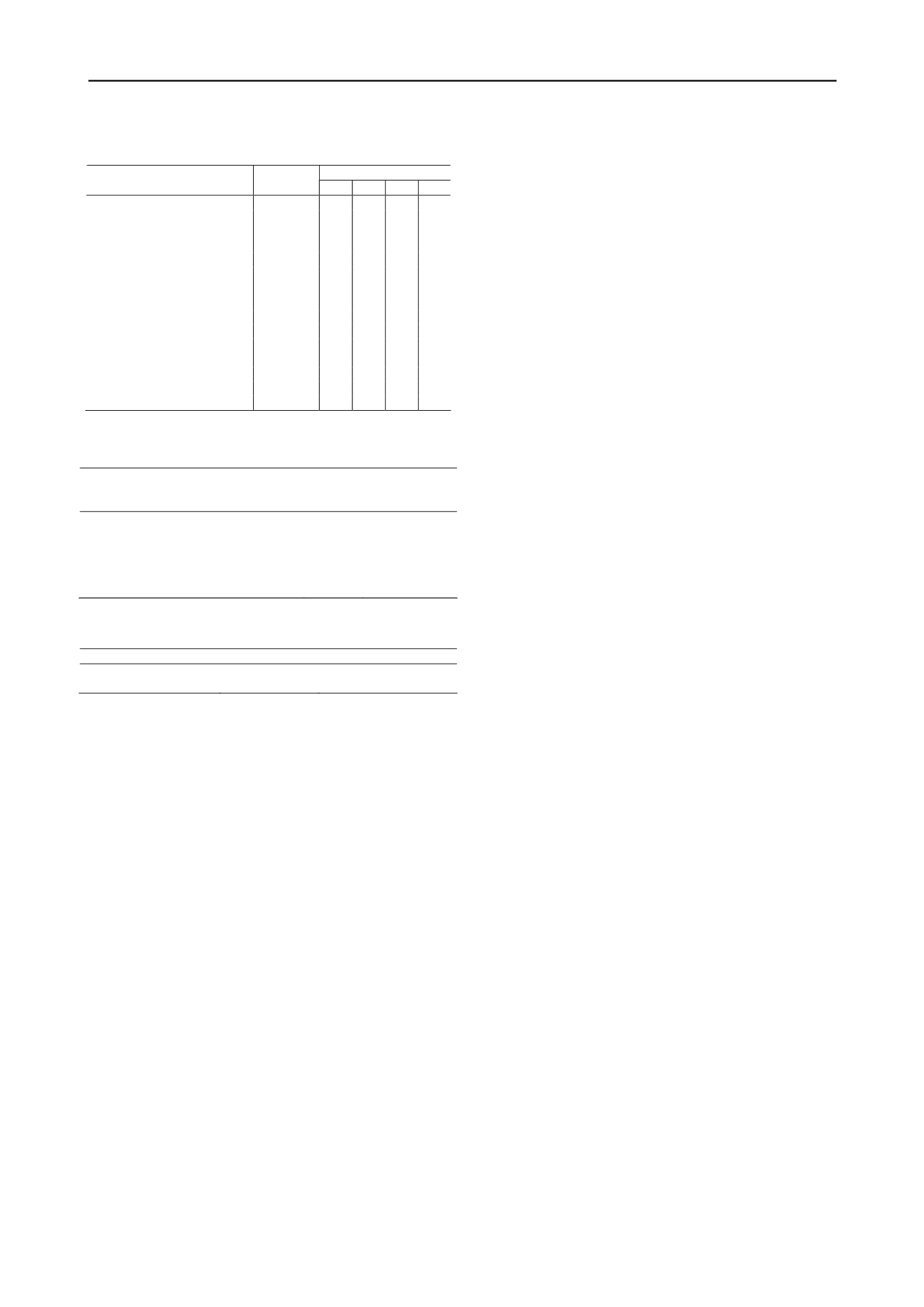
3202
Proceedings of the 18
th
International Conference on Soil Mechanics and Geotechnical Engineering, Paris 2013
Table 4 – Samples that did not meet the requirements of NBR
15.116:2004.
Samples
Parameters
NBR
15.116
i
i
ii
iii
Uniformity Coefficient (%)
≥ 10
4.88 3.62
39.28 14.88
Material through strainer Nº
40 (%)
Between
10 e
40mm
53.47 45.76
21.47 31.24
CBR (%) - Subgrade
≥ 12
10.20 18.70
190.5 129.7
CBR (%) - Sub-base
≥ 20
10.20 18.70
190.5 129.7
CBR (%) - Base
≥ 60
10.20 18.70
190.5 129.7
Subgrade Expansion
≤ 1
0.20 0.10
0
0
Sub-base Expansion (%)
≤ 1
0.20 0.10
0
0
Expansion (%) – Base
≤ 0,5
0.20 0.10
0
0
Maximum dimension of
grains (mm)
63.5
19.10 19.10 38.10 38.10
Shape Index
< 3.0
*
*
2.20 *
Depreciation
< 50
*
* 26.76 *
Sulphate Content (%)
< 2.0
0
0
0.05 *
i – Soil; ii – RCCR; iii – R60S40
* *Not determined
Table 5– Costs of the acquisition of materials for paving project.
Material
Unit
Unitary cost of
the acquisition
(US$)
Sand for landfill
m
3
14,00
RRCC obtained with mobile plant onsite
m
3
14,00
RRCC obtained from processing plant
outside the site
m
3
9,11
Simple graduated gravel (SGG)
m
3
20,41
Soil of the continuous helical pile
m
3
0*
* cost of transportation onsite disconsidered
Table 6 – Costs for the final disposition of wastes in licensed places.
Disposition place
Unit
Unitary cost (US$)
Inert Landfill
m
3
47,30
Processing plant
m
3
18,36
* cost of transportation onsite disconsidered
For the calculation of the financial impact of the use of the
investigated materials in paving project, two scenarios for reuse
of waste were considered:
Scenario 1: all the brute RRCC is taken to the processing
mill for recycling, and the pile soil is deposited in the inert
landfill. The layers of paving are executed with natural
aggregates;
Scenario 2: use of mixture of pile soil with RRCC in the
regularization of the terrain and the sub-base layer. The base
layer is performed with the remaining available RRCC and
another portion of natural aggregate (SGG).
In simulations, the volumes were calculated from the paving
projects (flexible and semi-rigid), land leveling and gabion wall
containment. In all cases, a bulking of 12% was admitted
(project value) and apparent specific weight of RRCC and the
soil is equal to 14 and 17 KN/m
3
, respectively.
The estimation of Scenario 1 presented a cost of US$ 2.2
million, while Scenario 2 showed a total cost of
US$ 320,498.21, in other words, the use of residues represent a
direct saving of about US$ 1.9 million continuing to meet the
technical requirements of the paving project, and allowing a
very significant reduction of environmental impacts that were
not valued.
In the implementation of the paving, the base layer only
contained simple graduated gravel (SGG), as an option of the
designer. Still, the direct saving obtained was almost the same
as in scenario 2.
In summary, demolition residues and the soil from the
excavation of helical piles were transformed into the “worksite
quarry”. The sustainable construction was cheaper than
conventional work, showing the potential of the "green
economy".
6 CONCLUSION
The article presents a case of building a shopping center in
Recife where the excavation residues of the 4,000 helical
foundation piles, in other words, about 25,000 m
3
of soil were
used in the layers of the paving work (regularization of the
terraind and sub-base). Demolition residues were also used from
old existing warehouses on the land, which were transformed
into recycled aggregates with a mobile plant installed at the
worksite.
The demolition residues and soil from the excavation of the
helical piles were transformed into the "worksite quarry". The
sustainable work was cheaper than the conventional
construction, showing the potential of the "green economy".
7 ACKNOWLEDGMENTS
The authors would like to thank the JCPM group for their trust
throughout the development of the study, especially Dr.
Francisco Bacelar. We also thank the Post-Graduation Program
in Civil Engineering of the University of Pernambuco, CAPES
(Brazilian funding agency) and FACEPE (funding agency of the
state Pernambuco).
8 REFERENCES
CÂMARA BRASILEIRA DA INDÚSTRIA DA CONSTRUÇÃO –
CBIC. Construção Civil: Desempenho e Perspectivas. Informativo
Econômico. Brasília, 2011.
Gusmão, A. D. (2008).
Manual de Gestão dos Resíduos da Construção
Civil
. 1a Edição. ISBN: 978-85-60917-04-4. CCS Editora.
Camaragibe.
Gusmão, A. D. (2011). Prática de Fundações no Recife. Fórum da
Construção do Recife.
NBR 7809:1983 NBR 7809:1983 – Agregado graúdo – Determinação
do índice de forma pelo método do paquímetro – Método de ensaio.
ABNT. Rio de Janeiro.


